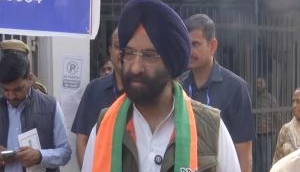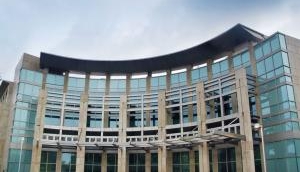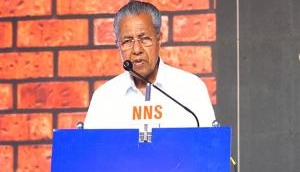
The 2019 general elections may be a fight for the BJP to secure a second straight term in office at the Centre, in West Bengal, it is a "semi-final match" for the saffron party before it takes on a redoubtable opponent in Mamata Banerjee in the assembly polls in 2021.
Ironically, despite being the land of Syama Prasad Mookerjee, the founder of Bhartiya Jana Sangh, the BJP's forerunner, the party was never reckoned as a potent political force in the state till the 2014 Lok Sabha polls, when it clinched 17 per cent votes and two seats.
The BJP, which edged past the Congress and the Left Front in the panchayat elections last year, hopes to ride the anti-incumbency factor and alleged "appeasement politics" of the West Bengal chief minister to position itself firmly as the main opposition party.
Factionalism in the once formidable CPI(M)-led Left Front, which Banerjee's Trinamool Congress (TMC) ousted from power after 34 years in 2011, and the Congress, has helped the BJP emerge as an aggressive opposition force in the state.
According to BJP leaders, the party currently has 40 lakh members in West Bengal. The BJP has, over the years, expanded its support base in tribal-dominated Junglemahal and in border areas which have a sizeable population of refugees from Bangladesh that were once considered the strongholds of the Left and the TMC.
The party, claim saffron party leaders, will benefit from the failure of the Left Front and the Congress to sew up an alliance, as it would result in a three-way split in anti-BJP votes, with the ruling TMC getting a sizeable chunk.
The BJP, they say, will now be locked in a direct fight with the TMC in constituencies like Cooch Behar, Alipurduar, Raiganj, Balurghat, Malda South in north Bengal, and Murshidabad, Krishnanagar, Ranaghat, Basirhat, Barrackpore, Asansol, Purulia, Jhargram, Bankura and Midnapore seats in south Bengal.
Enthused by its performance in the panchayat polls, when it won 7,000 odd seats in three-tier panchayati raj institutions, BJP president Amit Shah has set an ambitious target of winning 23 of the state's 42 Lok Sabha seats.
The party had won just two seats in 2014. Acutely aware that it would be a daunting, if not impossible, to repeat its performance in key Hindi heartland states of Uttar Pradesh and Bihar, where it had won 73 of the 80 seats and 31 of the 40 in 2014, the party is seeking to break new ground in states like West Bengal and Odisha.
Asking not to be named, a senior BJP leader said apart from the "vacuum" in the opposition space, "pervasive corruption" and "appeasement" of Muslims, who constitute around 30 per cent of the state's population, have helped the saffron party strengthen itself in West Bengal.
"Frequent communal riots in various parts of the state due to rise in infiltration and the fast changing demography of border areas have been important reasons behind the BJP emerging as the main alternative. The TMC has forgotten that the majority Hindu community is not happy with it," says state BJP chief Dilip Ghosh.
The Hindu right wielded considerable influence in violence-scarred West Bengal in the aftermath of Partition, before waning considerably over the years. In the first assembly polls in 1952, the Hindu Mahasabha and Jana Sangh together won 13 seats, pocketing around 8 percent votes.
The same year, Hindu Mahasabha candidate N C Chatterjee and Jana Sangh's Syama Prasad Mookerjee were elected to the Lok Sabha from Hooghly and Calcutta South-West seats. In the 1957 assembly polls, although the Jana Sangh drew a blank, the Hindu Mahasabha won 23 seats.
The death of Mookerjee in 1953 saw a sharp decline in the political clout of the Hindu right organisations, which were relegated to the fringes. The Indian National Congress and its splinter groups ruled the state from 1952 to June 1977, before the communists, who were gaining in strength since the late 1960s through agrarian movements, formed their government.
They would go on to play an epic 34-year innings in power till 2011 when Mamata Banerjee's party formed its government. After the BJP was launched in 1980, it hardly had any presence in the state and was ridiculed as the 'Party of Burrabazaar', the trading hub of Kolkata. Under Vishnu Kanta Shastri and Tapan Sikdar, a former Union minister, the BJP was considered a party of erudite men but largely remained on the margins during the Left rule.
In the 1991 Lok Sabha election that was held at the height of the Ram temple movement, the party failed to open its account in the state but made its presence felt with 12 per cent votes in its kitty. It failed to build on the momentum in the years that followed, and contested the 1998 election in alliance with the TMC.
The BJP won its maiden Lok Sabha seat when Sikdar emerged victorious from Dumdum. In the 1999 general election, when it again went to the hustings in alliance with the TMC, it won two seats and polled an impressive 11 per cent votes. It, however, drew a blank in the 2004 Lok Sabha and 2006 state assembly elections.
As Banerjee consolidated her position, she jettisoned the BJP in order to endear herself to Muslim voters. The saffron party managed to win the Darjeeling Lok Sabha seat in 2009, with the party polling around 6 per cent votes. Banerjee forged an alliance with the Congress for the 2011 assembly polls. The BJP drew a blank despite clinching around 5 per cent votes.
Things began to look up for the party in 2012 when its cadre began taking to streets against the Banerjee government over various issues as the Left was still smarting from the 2011 drubbing that brought an end to its 34-year unbroken rule in West Bengal. In the 2014 Lok Sabha polls, when a Modi wave swept across states, West Bengal did not remain untouched, and contesting alone the party went on to win Asansol and retain Darjeeling, polling 17 per cent votes.
The party clinched three seats in the 2016 assembly elections, and emerged as an aggressive challenger to the TMC in the panchayat elections when the state's ruling party was alleged to have ensured the victory of a large number of its candidates uncontested through strong-arm tactics.
Innumerable incidents of clashes between the TMC and BJP cadres were reported from across the state, prompting the Supreme Court to observe that thousands of seats going uncontested showed that democracy was not working in the state. The TMC, however, remains dismissive about the gains made by the BJP.
"The BJP might have votes in some pockets as Left and Congress are helping it, but the politics of communalism and violence will never work in Bengal as long as the TMC is here," TMC secretary general Partha Chatterjee told.
-PTI







![BJP's Kapil Mishra recreates Shankar Mahadevan’s ‘Breathless’ song to highlight Delhi pollution [WATCH] BJP's Kapil Mishra recreates Shankar Mahadevan’s ‘Breathless’ song to highlight Delhi pollution [WATCH]](https://images.catchnews.com/upload/2022/11/03/kapil-mishra_240884_300x172.png)

![Anupam Kher shares pictures of his toned body on 67th birthday [MUST SEE] Anupam Kher shares pictures of his toned body on 67th birthday [MUST SEE]](https://images.catchnews.com/upload/2022/03/07/Anupam_kher_231145_300x172.jpg)






